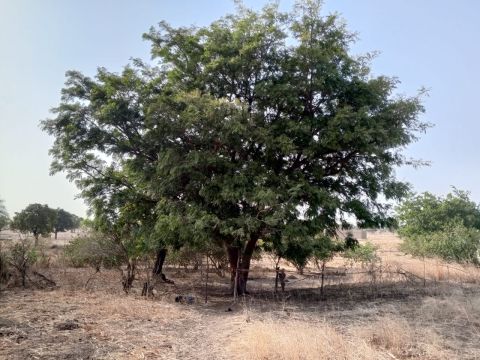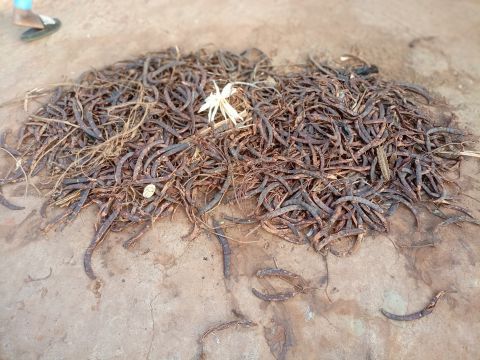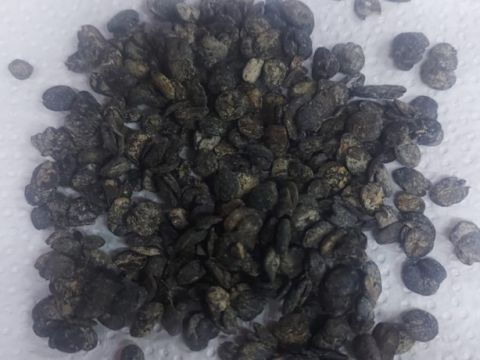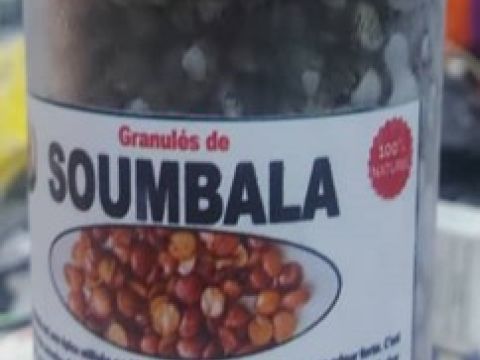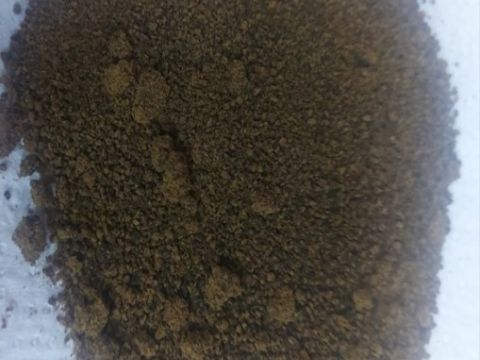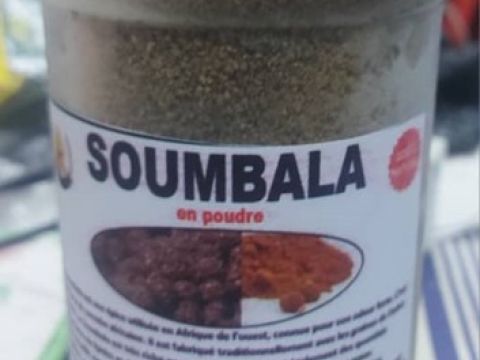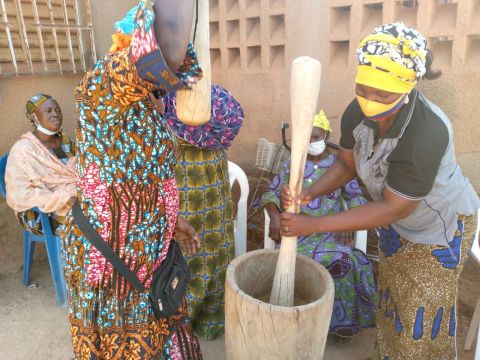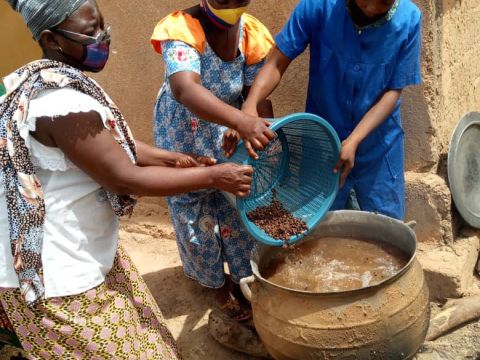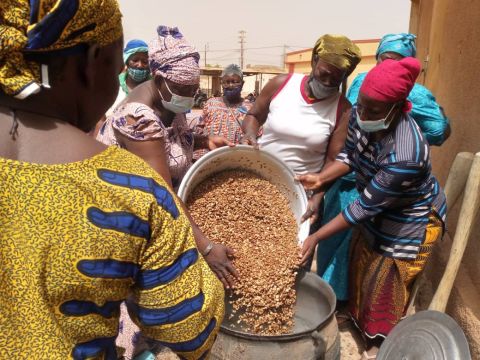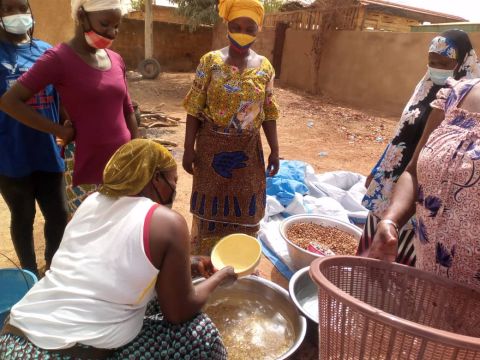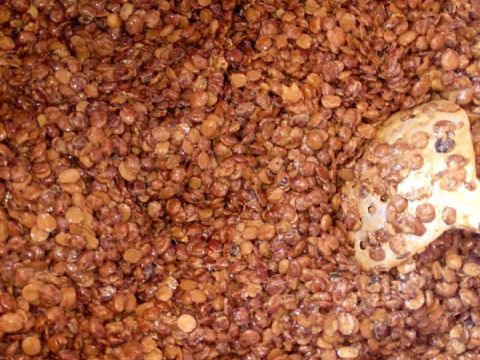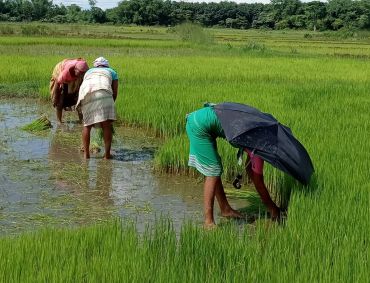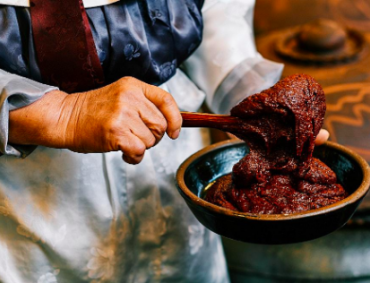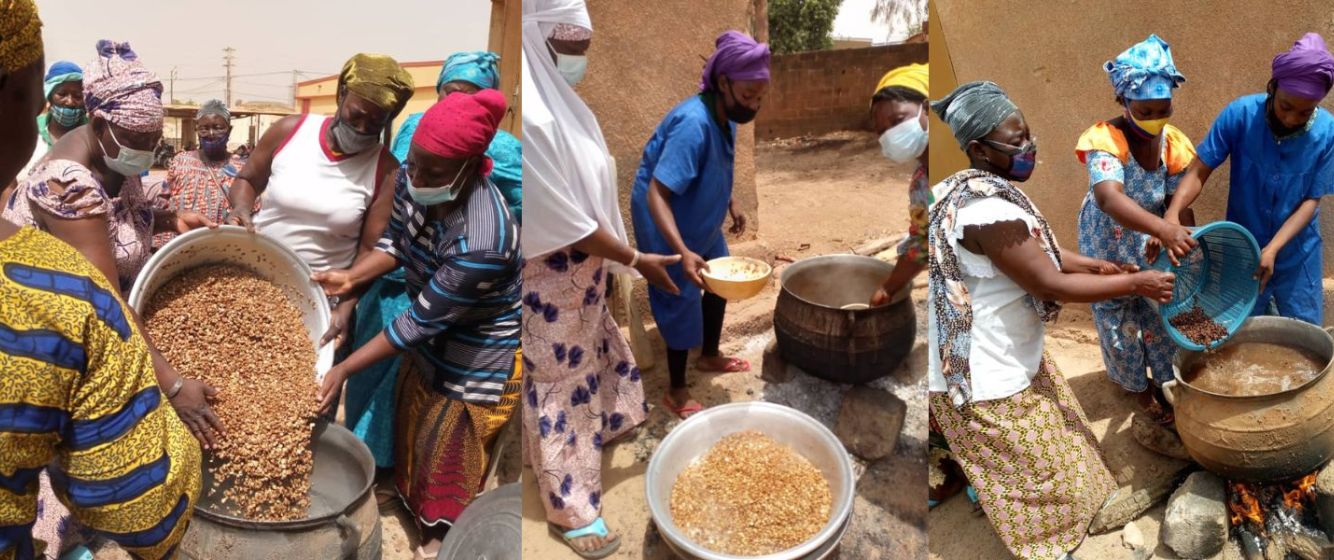
Burkinabe women soaking soumbala beans in boiling water to prepare them for grounding.
Photo Credit: Jocelyne Vokouma, 2024
Soumbala, a heritage of culinary art in West Africa
Soumbala, the fermented African locust bean, is a staple product in traditional African cuisine, which the modern world has transposed into its consumption habits by improving its quality through countless innovations, not only in the processes of its manufacture but also in its different modes of consumption.
In this HAB blog piece, I share some stories about the process of making soumbala in Burkina Faso I learned in conversation with soumbala producer and entrepreneur Mrs. Kargougou Ouédraogo Mamounata, the importance of soumbala to Burkinabe and West African culture, and its role as a form of know-how for women in West Africa.
The Néré Tree
The African locust bean tree or néré, is the plant from which soumbala originates. Going by the scientific name of Parkia biglobosa, the locust bean is one of the thirty-four known species of the Parkia genus. This tree can measure between 15m, 20m and 25m in height. Its geographical area stretches from Senegal in the west to Uganda in the east. Called the "tree of peace" in Guinea, the African locust bean is also known by various names such as mimosa powder, flour tree, fawn tree, or African carob tree.
The names of soumbala in West Africa
Culturally consumed in most families in its raw or cooked form, soumbala is known in several countries under various names such as:
- afitin, iru, sonru, in Benin;
- soumbala in Burkina Faso ;
- soumbara in Côte d'Ivoire;
- soumbara in Guinea Conakry;
- kalwa (among the Houssas), dosso maari or namouno (among the Zarmas) in Niger;
- dawadawa, iru in Nigeria and northern Ghana;
- kinda in Sierra Leone ;
- nététu in Senegal.
A sample presentation of soumbala in Burkina Faso
In Burkina Faso, soumbala comes in two forms: beans or ground.
Elsewhere, in other countries in West Africa, it comes in other forms such as a paste and fresh/wet like afitin.
It is the seeds of the African locust bean tree that constitute the raw material for the manufacture of soumbala. These seeds are found in pods which are the fruits of the African locust bean tree. The seeds of the African locust bean are sold at the market. So once the raw material is available, processing the seeds from the African locust bean to soumbala can begin.
Soumbala processing techniques
The technical processes for making soumbala are: manual sorting, soaking, a first shelling, a first cooking, a second shelling, post-cooking washing-sorting-screening, a second cooking, fermentation, drying, and packaging. Manual sorting removes impurities from the raw seeds of the African locust bean. Afterwards, the seeds are soaked in water for at least 30 minutes to eliminate bad seeds (immature, rotten, etc.). Soaking softens the seeds and makes the pounding job easier. For the first shelling, the seeds from the soaking are pounded in a mortar to extract the first layer of skin.
These seeds are dried, then stripped of bran and washed. This is an operation that can take three to four hours of time. Here, the use of a sheller is possible by facilitating the dry shelling of the seeds. It's innovation. The first cooking step consists of boiling the seeds obtained at the current stage in a pot grade to have more flexible and red seeds. The duration of this first firing is between twelve and thirteen hours.
Through the second shelling, the boiled seeds are again put back in a mortar to be pounded and more bran extracted.
With a sieve, the seeds are separated. This second shelling can last three to four hours. Through the washing-sorting-screening triptych, the seeds are washed, sorted and screened, in order to clean them well and rid them of other persistent residual particles.
For the second cooking, the seeds are put back into the fire in a pot containing water. This second cooking, which lasts two hours, contributes to the elimination of pathogenic germs. This reheating prepares for the fermentation stage. This phase consists of fermenting the cooked seeds for a second time for forty hours. Thus, a clean basket and empty bags are used depending on the quantity to be fermented. The seeds processed by hand since the beginning of the process will be poured into the bag spread out in a basket. The bag is folded up, then the basket is neatly covered. After fermentation, it is drying. The fermented seeds are dried with a view to being ground and kept in pellet condition for sale and consumption. At this stage, the seeds can be given any shape you want, such as balling, or kept as such before packaging.
Packaging varies from one artisan to another and the packaging available depends on whether the finished product is intended for export.
In terms of estimate, the available data indicate that five to six women can process one ton of locust seeds in a week. However, with 30 kg of African locust bean fruit, a woman can obtain 15 kg of dried seeds that she transforms into 6 kg of soumbala.
Soumbala contains the following vitamins: Iron (Fe), Sodium (Na), Zinc (Zn), Potassium (K), Magnesium (Mg) and Manganese (Mn). Indeed, "in 100 grams of these seeds contain 443mg of phosphorus, 465mg of potassium and 435mg of calcium". Generally used after fermentation, African locust bean seeds are very rich in protein (41%) and fat (21%).[vi] In terms of comparison, "for 40 kg of African locust bean, it would take 46 chickens to have as much protein and 61 to have as much fat and 57 to have as many calories as the soumbala obtained by processing.
Soumbala as know-how
The activity of processing African locust bean seeds into soumbala is a work that is the knowledge and know-how of women throughout West Africa. Because, since the dawn of time, it is women who have had the expertise in the transformation of African locust bean seeds into soumbala. However, "in the family fields, men now claim exclusive ownership of the resource. In Benin, men have the right to the trees and women pick and prepare the condiment. In Guinea, men grant women the right to own the African locust bean in the fields."
Although the African locust bean tree grows naturally in the bush, in terms of gender relations, men have nevertheless found ways to impose their rights on this important resource, which generates products from the harvest. Beyond the food sector, the leaves, bark and roots of the African locust bean tree contain effective and very well-known therapeutic potential. Considered a community resource, the locust tree is a source of social cohesion and represents "the link between the underworld and the sky, the place of residence of the spirits of the forest."
Whether in the form of seeds or powder, soumbala as a seasoning is a popular choice for enhancing the flavor of West African dishes, to the point where being included in non-traditional dishes like chocolate, pasta, and rice. Given the central place it occupies in the eating habits of households and its processing techniques being a form of know-how for West African women, it can be considered without hesitation as a heritage of culinary art in West Africa.
Credits:

